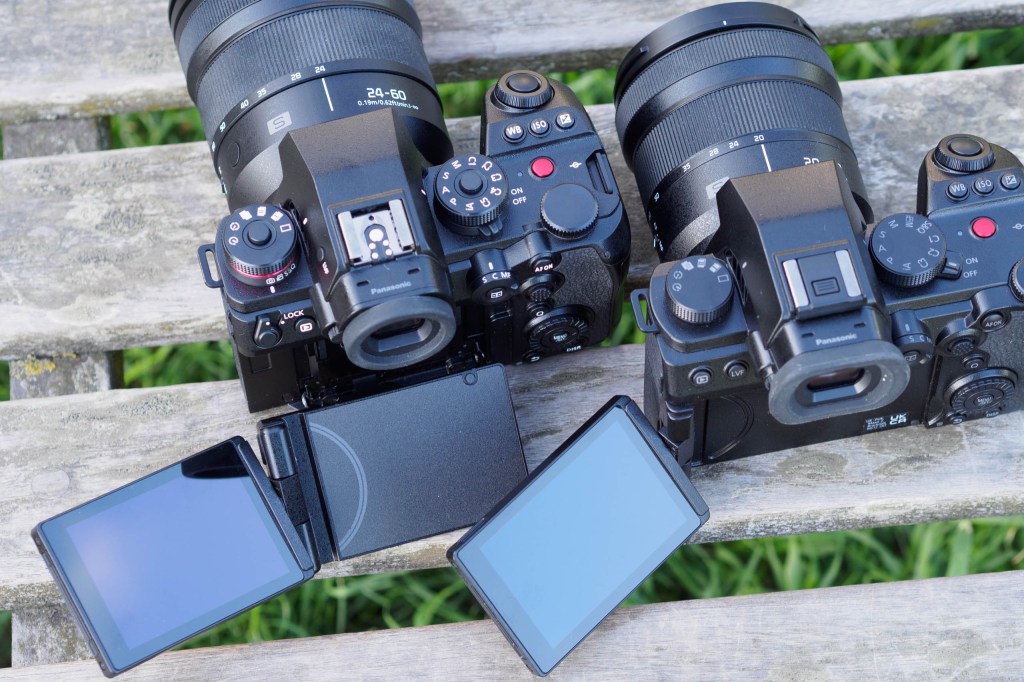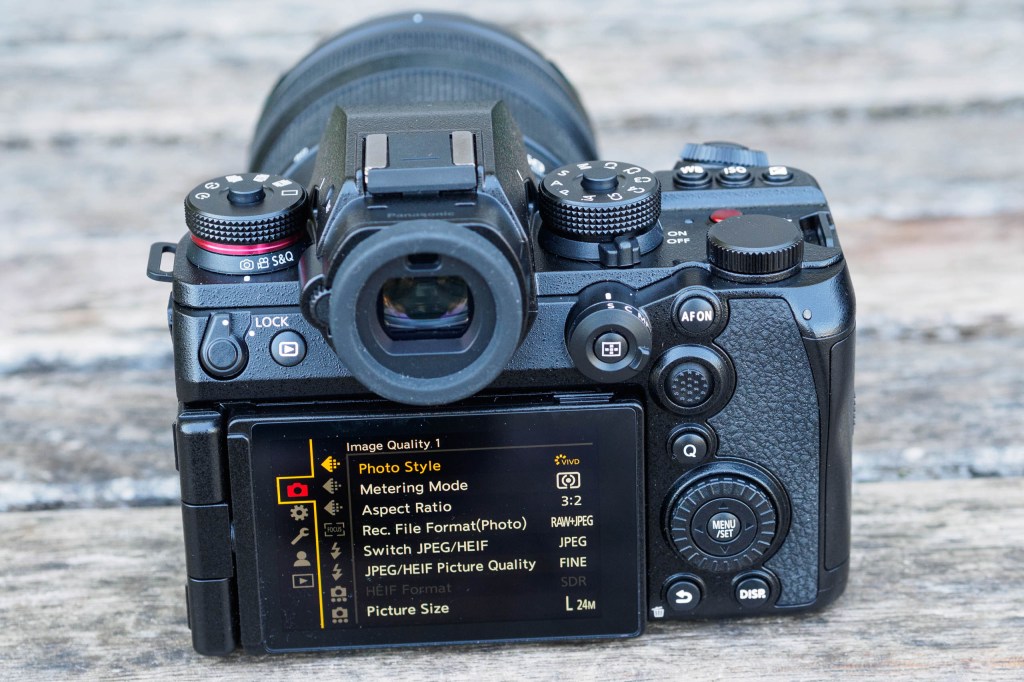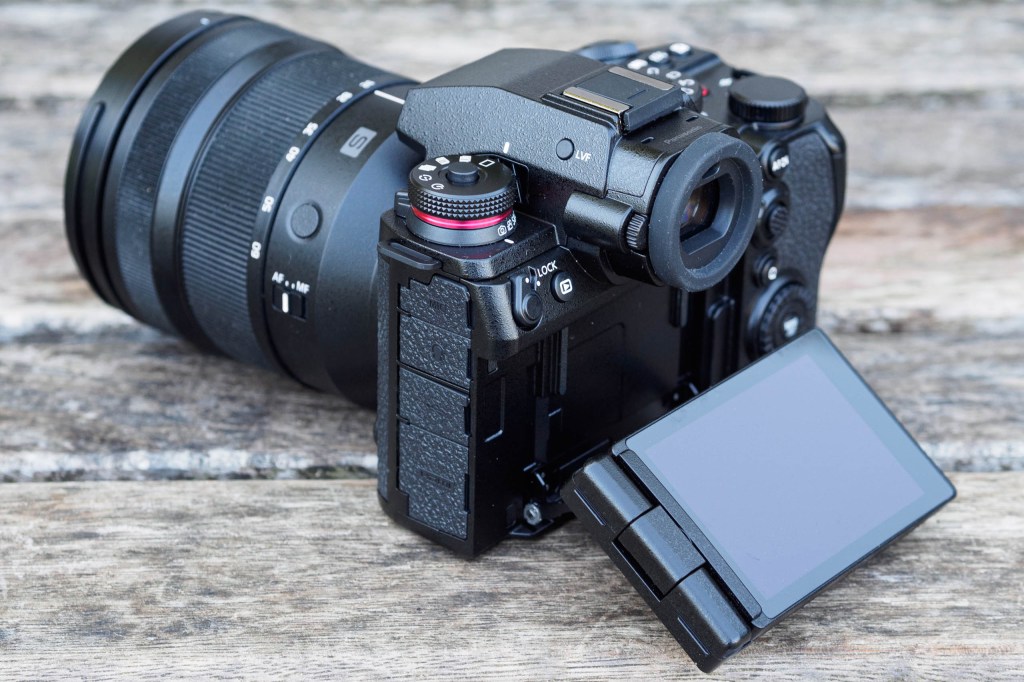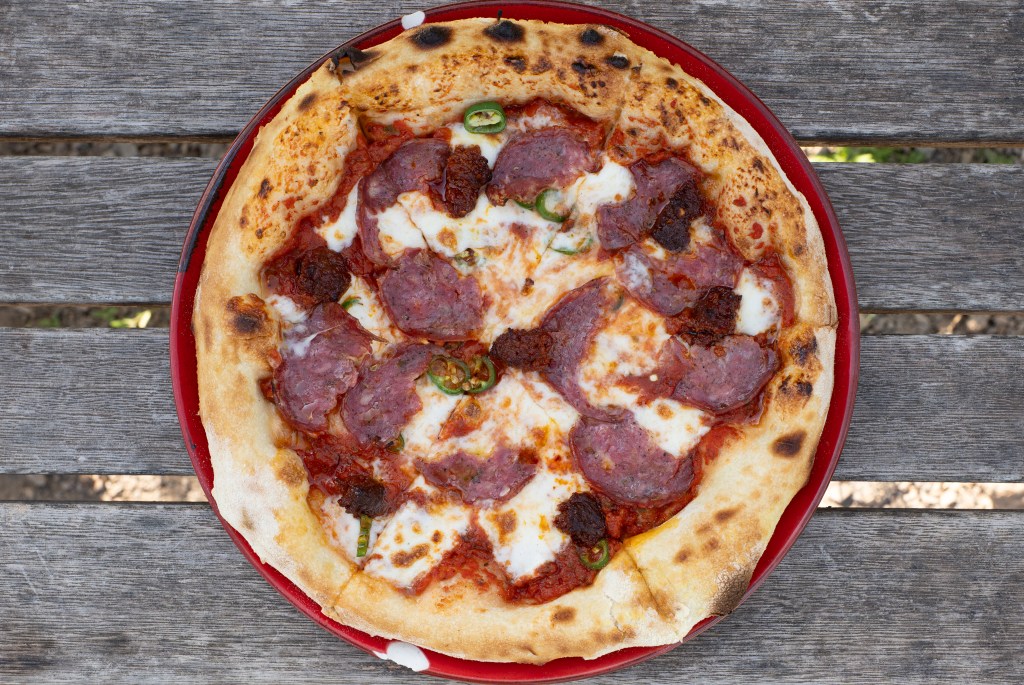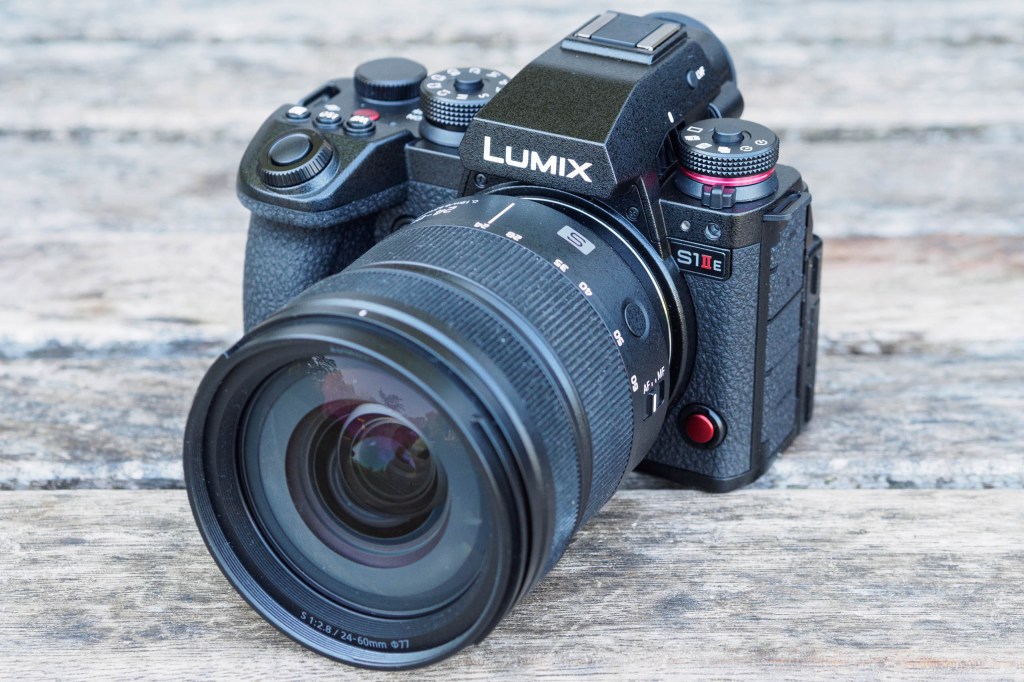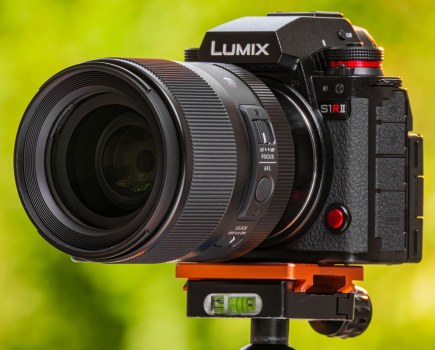Amateur Photographer verdict
The Panasonic Lumix S1IIE aims to provide the ‘essential’ features of the pricier S1II. It’s a very capable camera, but I suspect most buyers at this level would rather pay more for the better model.- Excellent build and handling
- Highly refined control layout
- Large, detailed viewfinder and versatile articulated LCD
- Very effective in-body image stabilisation
- Genuinely practical high-resolution multi-shot modes
- No auto subject-detection mode
- No intermediate burst speed between 10fps and 30fps
Back in February 2025, Panasonic launched the S1RII – a pro-spec full-frame mirrorless camera with a 44MP sensor. Less than three months later, it followed up with not just one, but two new 24MP models that share the same body design. The difference between them is that the S1II has a ‘partially stacked’ sensor that enables high-speed shooting, while the Panasonic Lumix S1IIE (E for “essentials”) uses a more conventional BSI-CMOS sensor. Chances are one of these will make it onto our list of the best Panasonic cameras – but which one?
Panasonic Lumix S1IIE at a glance:
- $2499 / £2299 body-only
- £2999 with 24-105mm F4 lens
- 24MP full-frame sensor
- ISO 100-51,200 (standard)
- Up to 30fps shooting
- 6K 30p, 4K 60p, Full HD 120p video recording
- 5.76m-dot, 0.78x OLED viewfinder
- 3in, 1.84m-dot tilt/vari-angle LCD
At $2499 / £2299 body-only, the S1IIE costs about 80% of the Lumix S1II’s price ($3199 / £2899). However, the differences between the two cameras aren’t necessarily huge. For stills, the S1II can shoot at a seriously impressive 70 frames per second using its electronic shutter, whereas the S1IIE can ‘only’ manage 30fps. When it comes to video, the S1II again offers faster framerates at many resolutions, along with higher specified dynamic range. But elsewhere, a line-by-line spec comparison shows the two cameras to be near-identical – at least on paper.
At this price point, the S1IIE finds itself up against the likes of the Nikon Z6III, Canon EOS R6 Mark II, and Sony Alpha A7 IV. A comparison with the Nikon Z6III is particularly interesting, as it uses a 24MP partially-stacked CMOS sensor like the S1II, but at about the same price as the S1IIE. It boasts a more sophisticated subject-recognition autofocus system, but not quite as high-end a body-design. So does the S1IIE’s balance of features make sense in the face of such stiff competition?
Features
Panasonic says that that the S1IIE employs a 24MP full-frame BSI-CMOS sensor that’s similar to the one in the older Lumix S5II and Lumix S5IIX. It provides a sensitivity range of ISO 100-51,200 as standard, which can be extended to ISO 50-204,800. That’s pretty much standard for this type of camera.

Like the firm’s other full-frame models, the S1IIE uses the L-mount that was originally designed by Leica and is also shared with Sigma. A good range of lenses is available from the three makers, with focal lengths ranging from 14mm to 600mm. Third-party lenses are starting to become available too, from the likes of Samyang and Sirui.
As previously stated, the S1IIE can shoot at 30fps in raw using its electronic shutter. Switch to the mechanical shutter, and this drops to 10fps with focus fixed, or 8fps with continuous AF. Engage Image Priority mode, which records 14-bit rather than 12-bit raw, and you get 7fps with AFS or 6fps with AFC (all these speeds are the same as the S1II and S1RII).
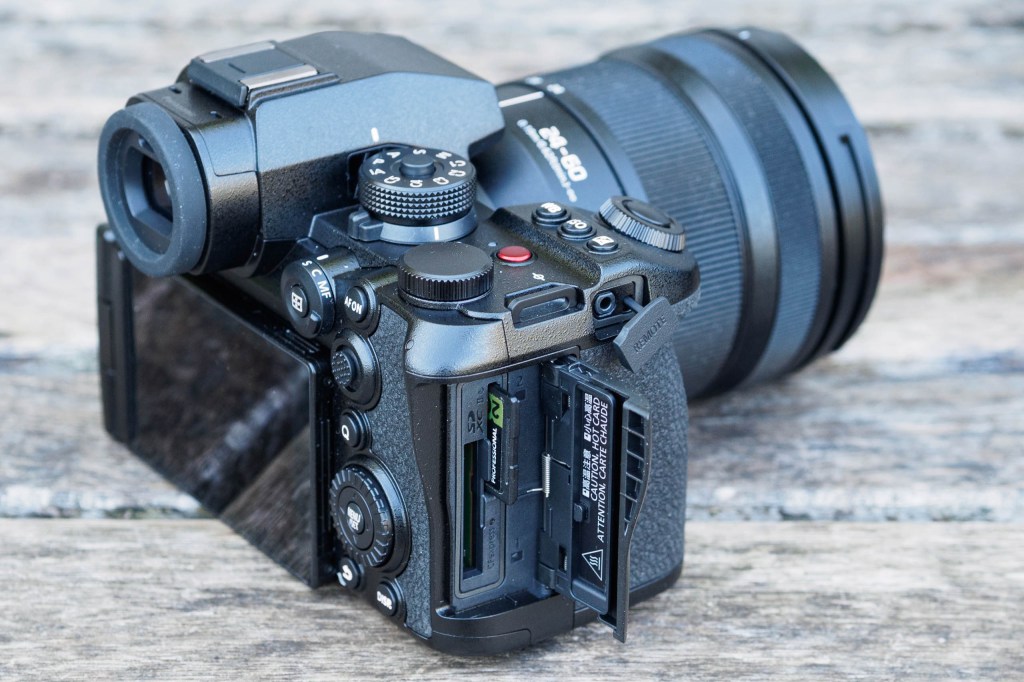
For autofocus, there are subject detection options for humans, animals (including birds), cars, motorbikes/bicycles, trains and airplanes. Unfortunately, though, there’s no Auto-selection option. When photographing people, there’s a new mode specifically for ‘Urban Sports’, such as breakdancing, parkour and skateboarding. Face and eye detection and tracking are also said to be improved over previous Lumix models, which is probably more useful for most users.
You get the same in-body image stabilisation (IBIS) as the S1RII, which promises up to 8 stops of shake reduction when shooting hand-held. Panasonic has also included high-resolution multi-shot modes for hand-held and tripod-based shooting. These modes are available from the drive mode dial and create a 96MP composite raw directly file in-camera. There’s a choice between two JPEG output resolutions, either 48MP or 96MP.
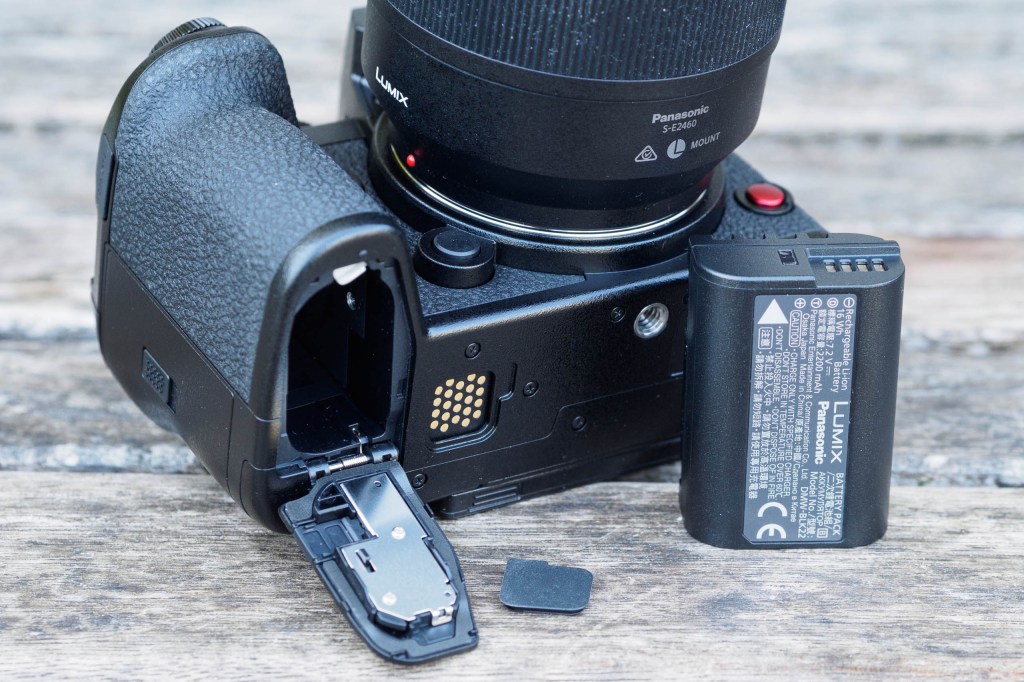
In a notable first for Panasonic, the S1II and S1IIE become the firm’s first models to support HEIF format as a high-quality alternative to JPEG for still images. Here there’s a choice of shooting in standard dynamic range (SDR) mode, or high dynamic range (HDR) using Hybrid Log Gamma. In principle, this allows extended highlight detail to be recorded and displayed on compatible screens. However, HEIF support is still very limited compared to JPEG.
Built-in Wi-Fi and Bluetooth provide smartphone connectivity via the Lumix LAB app. Here you get all the expected options, including the ability to copy photos and videos to your smartphone for editing and sharing. There’s both a basic Bluetooth shutter release and a comprehensive remote control via Wi-Fi. You can also use the app to download LUTs and copy them to the camera for colour-grading your output, either video or stills.
Video features
While the S5IIE doesn’t offer such fast video frame rates as the S5II, it’s still pretty capable. It can record 6K video at 30fps in 17:9, 16:9, or 3:2 ‘open gate’ formats, with the latter enabling cropping to various aspect ratios in post-processing. 4K recording is limited to 30p uncropped, but 4K 60p is available with an APS-C (1.5x) crop. Full HD 120p is also on offer.

Panasonic has also added a new 2.4:1 ‘Cinemascope’ format, which allows 6K 60p and 4K 60p recording using the full sensor width. The camera can also record Apples ProRes RAW and ProRes RAW HQ internally to a CFexpress Type B card, at up to 5.8K 30p, or C4K 60p. Dynamic range is specified as 14+ stops in V-Log.
Panasonic Lumix S1IIE: Key features
- Power: Panasonic’s standard DMW-BLK22 battery is rated to deliver 380 shots using the LCD and 340 with the EVF, and charges in-camera via USB-C
- Connectors: On the left side you’ll find microphone, headphone, USB-C and full-size HDMI ports. Panasonic’s proprietary 2.5mm remote release is on the handgrip
- Storage: One card slot accepts CFexpress Type B media, while the other is for UHS-II SD. It’s also possible to record directly to a USB-C SSD.
- Fan: A cooling fan is built-in, with vents on either side of the viewfinder housing. There’s no hard limit to the video recording time
- Vertical grip: All three S1 models are compatible with the same BMW-BG2E vertical grip, which boasts a replicate set of shooting controls and a hot-swappable battery. It costs $350 / £299.
- Mode switch: A new switch beneath the drive dial selects between photo, video, and slow-and-quick shooting modes
Panasonic Lumix S1IIE vs S5IIX design comparison image gallery
Here, you can see how the Lumix S1IIE compares side-by-side with its slightly cheaper sibling, the S5IIX. the two cameras look very similar, but the S1IIE is a step up with, among other things, a higher resolution viewfinder, more versatile screen articulation, and support for faster CFexpress type B cards.
Build and Handling
For the S1IIE and S1II, Panasonic has used exactly the same body design as the S1RII, with the three cameras distinguishable only by their name badges. This makes a lot of sense for anyone who uses more than one of these models, as all the controls are in all the same places, and work in the same way. As the S1IIE is essentially identical to the S1RII in terms of handling and operation, much of the following text is repeated from my review of that camera.
Measuring 134.3 x 102.3 x 91.8mm and weighing in 795g including the battery and SD card, the S1IIE is broadly similar in size to the Canon EOS R6 Mark II, Nikon Z6III, and Sony Alpha A7 IV. It’s the heaviest of the group, though, which reflects its chunky build. The viewfinder sticks quite a long way out of the back, due to the fan that’s integrated into the front of its housing. This means it takes up a little extra space in a bag, but also makes it a bit more comfortable to use.
Thanks to a deep handgrip and a small but effective thumb hook, the camera feels extremely secure in your hand. Its magnesium alloy body is dust and splash resistant and freezeproof down to -10 °C, at least. The exterior is covered in buttons, dials and switches, giving direct access to all the most important camera settings.
Overall, you get the same excellent handing as previous Panasonic cameras. There are three electronic dials for changing exposure settings, plus a well-placed 8-way joystick on the back and a large drive mode dial on the top left.
A row of buttons behind the shutter release provides quick access to white balance, ISO, and exposure compensation, while secondary functions are easily accessed via the Q button on the back. Pretty much the entire interface can be operated by the touchscreen, which complements the physical controls perfectly.
One noteworthy update over the older S5II design is a still/video/S&Q switch beneath the drive mode dial; previously, everything was accessed from the exposure mode dial. Photo and video settings are now kept entirely separate, too, which is welcome for users who jump back and forth between them.
The power switch has been redesigned so it’s easier to flick with your right thumb, and both the exposure mode and drive dials gain toggle-lock buttons, so they don’t get knocked by accident. A switch on the left shoulder allows you to lock any subset of the other controls to prevent inadvertent settings changes.
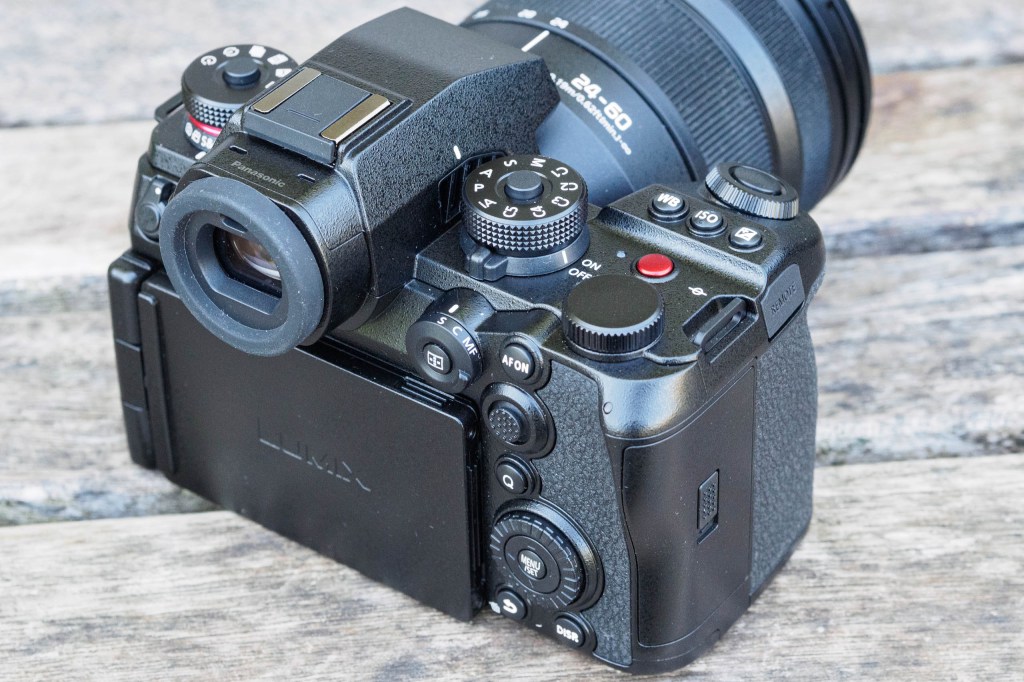
On the back, the AF mode/area control is now further away from the viewfinder compared to the S5II, so it’s easier to access. Meanwhile, the top rear dial has been repositioned slightly leftwards. This means that all the controls operated by your right thumb are more tightly clustered, which makes the camera just that bit quicker to use.
A second video start/stop button is placed on the front, which is handy if you like to record yourself. Personally, though, I find it’s far too easy to press by accident, so I disabled it in photo-shooting mode. You don’t get the handy audio control button that’s on the Micro Four Thirds GH7, but it’s possible to map this to any function button.

No fewer than 5 custom positions on the mode dial (labelled C1-C5) allow you to store camera setups for different kinds of shooting. These can be given meaningful names, too, which are shown onscreen for a few seconds when you select a C mode, to help you remember what you’ve set them to do. However, you always have to keep in mind that the focus and drive modes are defined by their physical controls, and remember to set these appropriately too.
Out-of-the-box, the S1IIE’s control dials are oddly underused. Both the top dials do the same thing except in manual exposure mode, while the rear wheel sets the audio output volume (which is fine for video, but not for photography). Thankfully every single control is customisable, so I reconfigured the top thumbdial to change exposure compensation, and the wheel on the back to set ISO. Set like this, I found the camera a pleasure to shoot with.
Viewfinder and screen
One area where the S1IIE stands out within its class lies with its viewfinder and screen. Its 5.76m-dot, 0.78x magnification EVF provides an impressively large, clear view, which is matched for size and resolution among its peers only by the Nikon Z6III. Meanwhile the LCD has the most versatile articulation mechanism that you’ll find at this price point.
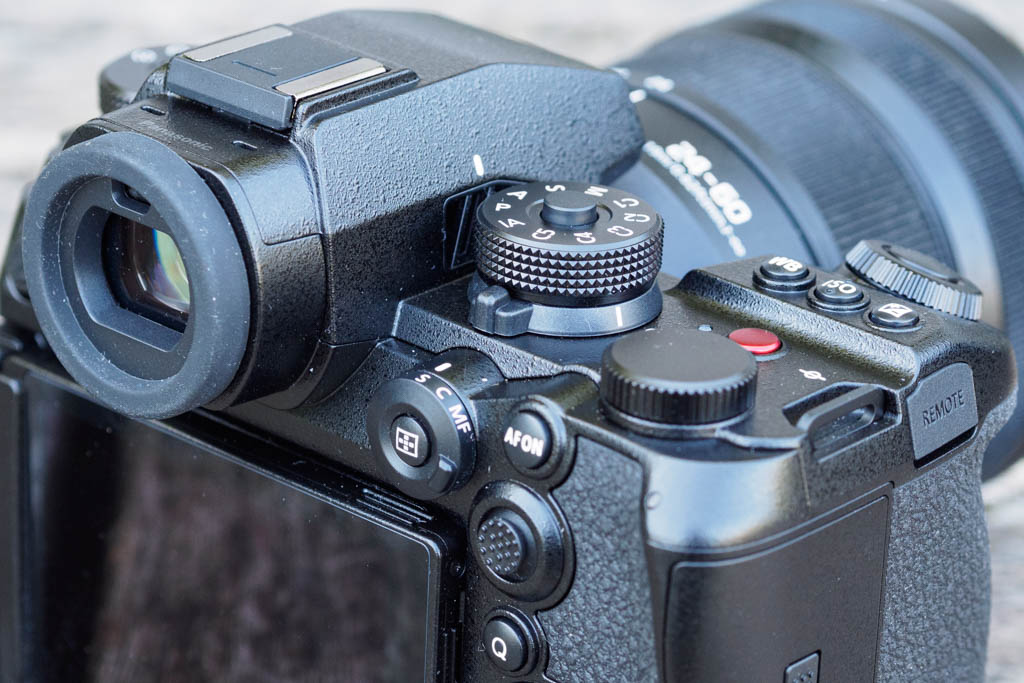
Exposure, white balance and colour are all previewed by default, giving a good idea of how your shots should turn out. However in a change from how older Lumix models work, the preview image is displayed at the set aperture by default, which provides a live depth-of-field preview (previously, you had to press a button on the camera’s front). The aperture opens up again when you half-press the shutter button.
All the expected compositional aids are available, including gridlines, a level display, a live histogram, and focus peaking. In video mode you also get such things as a vectorscope for judging white balance and colour, and a waveform display that shows the distribution of lighting levels across the frame. But unfortunately, you can’t view these both at the same time, or indeed use them for stills.
As for the screen, this employs a side-hinged vari-angle mechanism, which is placed on a frame that can be tilted up or down. This allows the screen to be pointed at practically any angle you please. It’s every bit as useful for photographers shooting at awkward angles in portrait format as it is for vloggers filming themselves in front of the camera.
The fact that you can pull the screen away from the back means that it doesn’t conflict with microphone or HDMI cables plugged into the side of the camera, either. Unlike side-hinged screens, it also works perfectly well with L-brackets for vertical shooting on a tripod.

Autofocus
When the first-generation Lumix S1 appeared in 2019, autofocus was probably Panasonic’s weakest point. But that turned around with the adoption of phase detection on the S5II at the start of 2023. The S1II series now includes a pretty sophisticated subject detection system, too, which brings its capabilities much closer in line with its rivals. For anyone updating from an older Panasonic camera, it’ll be a revelation.
Subject recognition includes settings for humans, animals (including birds), cars, motorcycles, bicycles, trains, and airplanes. Eye detection is available for both humans and animals, and with vehicles you can tell the camera to focus on the most important part, which is usually the front. Unfortunately, though, here’s no Auto mode that can detect the subject type, so you always have to specify in advance which of them you’re going to be shooting.
Panasonic also does a good job of clustering the AF controls close together under the control of your right thumb. All the area and subject detection settings are accessible via a button in the middle of the focus mode selector switch, with the AF-ON button and joystick alongside. Once you’ve mastered how it all works, it’s quick and easy to tailor the focus settings to suit different shooting situations.

I only had the Lumix S 24-60mm F2.8 lens available while testing the camera, which somewhat limited my ability to push the autofocus system to its limits. But overall, I got much the same impression from the S1IIE as I did from the S1RII. With both humans and animals, the subject recognition can find and track focus on subjects reliably, even when they’re small within the frame. When it identifies multiple possible options, you can select between them using the joystick.
It’s worth bearing in mind, though, that one of the benefits of a partially-stacked sensor lies with snappier focus tracking (I certainly saw this with the Nikon Z6III). So if you’re likely to be shooting erratically moving subjects, it’s likely that the S1II will be a better choice than the S1IIE. Unfortunately, though, I wasn’t able to test the two cameras side-by-side.

One oddity with the AF system appears when you combine subject detection with tracking. If the camera can’t find a subject of the specified type, then it won’t fall back on its conventional tracking mode like the S5II does, but instead it simply gives up. For some users this will be infuriating; others won’t notice or care. But it would be nice for Panasonic to fix this flaw with a firmware update across the entire S1II line.
You don’t have to use subject detection, of course, and can use the conventional AF system instead. Here you get a wide range of focus area sizes and shapes which can be positioned freely within the frame. This performs very well indeed, giving consistently accurate focus with minimal fuss.
Performance
Overall, the S1IIE is every bit as responsive as you’d expect from a camera with professional aspirations. Panasonic appears to have cured the intermittent startup lag that I’ve seen with other recent Lumix models, so now it’s always ready to shoot the moment you flick the power switch. The shutter sound is fairly unobtrusive, too, firing with a soft, low-pitched clack.

Battery life is absolutely fine, and clearly better than the S1RII, as indicated by the CIPA rating of 340 shots using the viewfinder (vs 280). As always, this rating is based on taking individual shots at a time; you’ll get many more than this when shooting bursts, especially with the electronic shutter.
You can also top up the battery in-camera in breaks during shooting, and unlike some cameras, the S1IIE doesn’t demand a USB-C PD source for recharging. This means you can charge it using a small powerbank or low-powered charger plug if necessary.

On the subject of continuous shooting, in my testing the camera matched its advertised speeds of 30 frames per second using the electronic shutter, 10fps using the mechanical shutter with focus fixed, and 8fps with C-AF, with a buffer of at least 180 frames. That should be more than enough for most users.
Slightly surprisingly, write times aren’t dramatically faster when using a CFexpress card compared to UHS-II SD, with the camera taking roughly 37 seconds and 47 seconds to clear its buffer completely with each card type, respectively. So unless you’re pushing the camera to its limits, you won’t necessarily get much of a performance boost from CFexpress. You will need it for highest-quality video recording, though.

It’s worth noting, though, that there are no intermediate burst rates between 30fps and 10fps, which would have been useful. Another quirk is that files shot in a 30fps burst get grouped together in playback, which means you can skip past an entire set with one button press, or delete them all at the same time. But those shot at slower speeds don’t, so you have to browse through them all individually.

Panasonic’s image stabilisation works really well for both stills and video shooting. Using the Lumix S 24-60mm F2.8 lens, I was able to get consistently sharp hand-held shots at shutter speeds up to about a second. When recording video, you can get almost tripod-steady results hand-held using the Boost mode. This is all very impressive, and a match for any other full-frame camera.
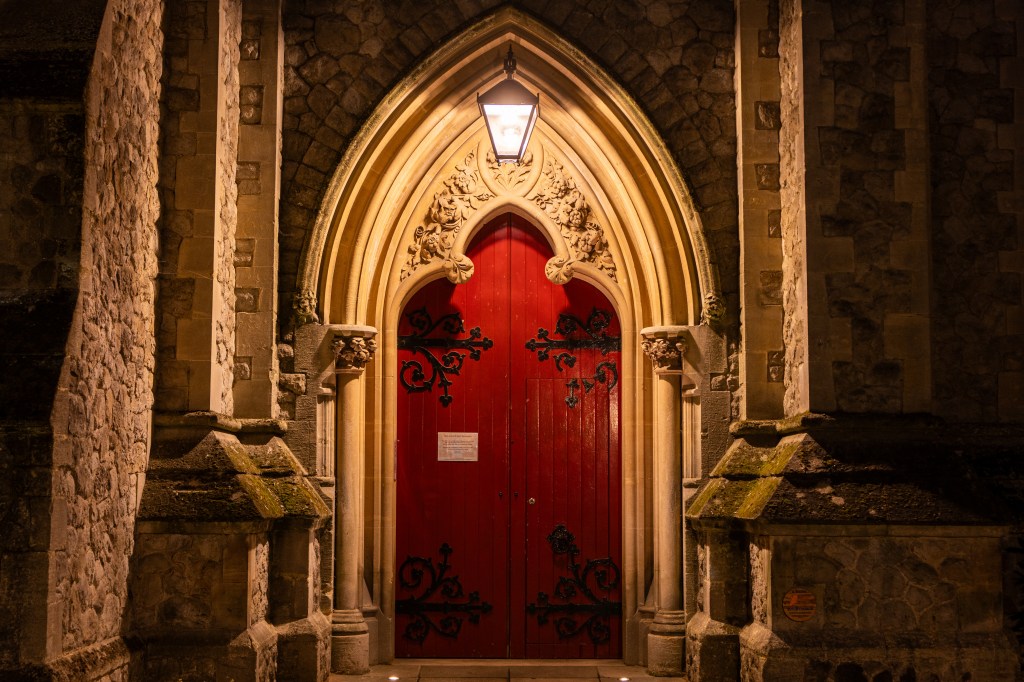
One area where the S1IIE stands apart from other 24MP full-frame cameras is in having a practical and usable high-resolution multi-shot mode. This is two distinctly different modes rolled into one, for hand-held and tripod-based shooting. It’s engaged directly from the drive mode dial and generates composite files in-camera, rather than requiring you to load a set of raw files into a computer afterwards.

Hand-held mode uses a process called super-resolution, which blends together multiple 24MP frames to extract extra detail. This gives visibly increased detail that’s a good match for the 48MP JPEG option. Tripod mode, meanwhile, uses the pixel-shift method, with the IBIS system precisely shifting the sensor between shots to sample the scene in higher detail. This can get close to the full 96MP resolution.
Tripod modes generally struggle with elements that move between exposures, but Panasonic’s processing does a pretty convincing job by filling in those areas with single-shot data.
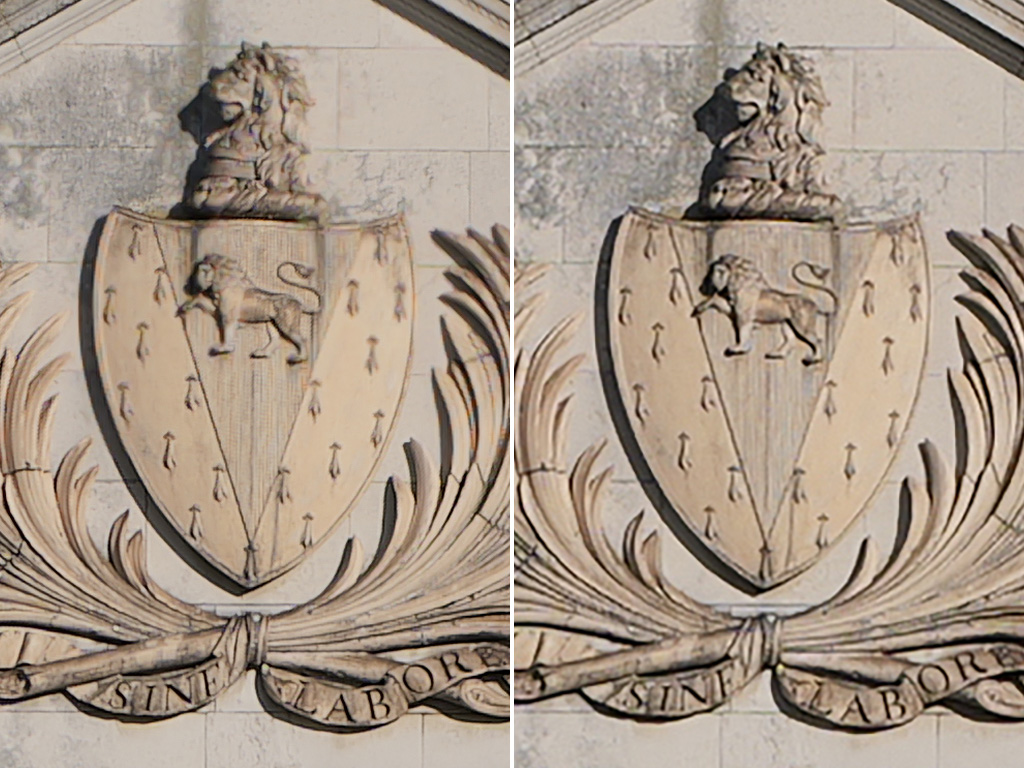
As usual with Panasonic, my main irritation is that the hand-held and tripod modes share the same menu for shooting settings. But you’ll almost certainly want to use different options for each. It would make much more sense for the two to be treated as entirely different modes with separate settings.
When it comes to metering, the S1IIE is generally very reliable. Like many cameras, it can sometimes be prone to clipping small areas of highlight detail in bright, high-contrast conditions, and then you’ll want to dial in some exposure compensation. But it’s usually easy enough to spot this in the viewfinder.
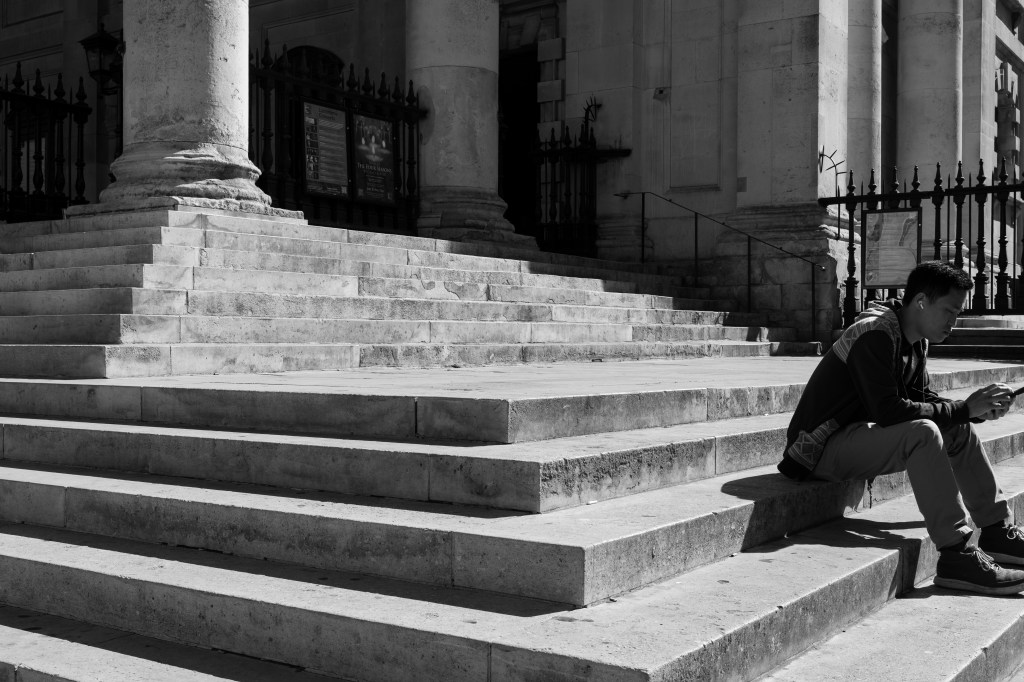
Auto white balance is generally biased towards giving neutral tones, but Panasonic offers both cool and warm alternatives if you prefer. There’s also an AI-AWB option available, but only for in-camera raw processing. I’ve found that this is well worth trying when the camera hasn’t got things quite right first time, as it often gives better results.


Likewise, Panasonic’s Standard Photo Style is tuned to give technically accurate colours. I prefer my images to have a bit more punch out-of-camera, so usually switched to the Vivid mode for shooting in colour. If you like shooting in black & white, Panasonic includes no fewer than five profiles with different tonalities – the Leica Monochrome option is probably my favourite of these overall.

As for raw image quality, unsurprisingly that looks pretty much the same as the S5II and S5IIX – and indeed a whole host of other cameras that probably all use the same sensor. This means it’s very much in line with what we’d expect for a 24MP full-frame camera. At low ISOs, you get plenty of detail, along with almost limitless scope for manipulating tonality sliders to pull up darker areas of the image.

Images remain pretty much clear of noise at sensitivities up to ISO 1600, beyond which detail and colour progressively degrade. But you can still expect to be able to shoot at settings as high as ISO 25,600 and get usable results, especially given the capabilities of AI noise reduction software such as DxO PureRaw and Adobe Denoise.
Panasonic Lumix SIIE: Our Verdict
Let’s make one thing clear from the start – the Panasonic Lumix SIIE is a seriously accomplished camera. You get a robust pro-spec body, with an excellent control layout and handling, rounded off by a fine viewfinder and an extremely versatile screen. It provides impressive image stabilisation, plus Panasonic’s usual huge range of video features. The image quality is a match for any other 24MP full-frame camera, and if you occasionally need higher resolution, then its multi-shot mode is unusually practical and delivers pretty good results. Its autofocus may not quite be the best in its class, but I suspect it’ll be plenty good enough for most users.
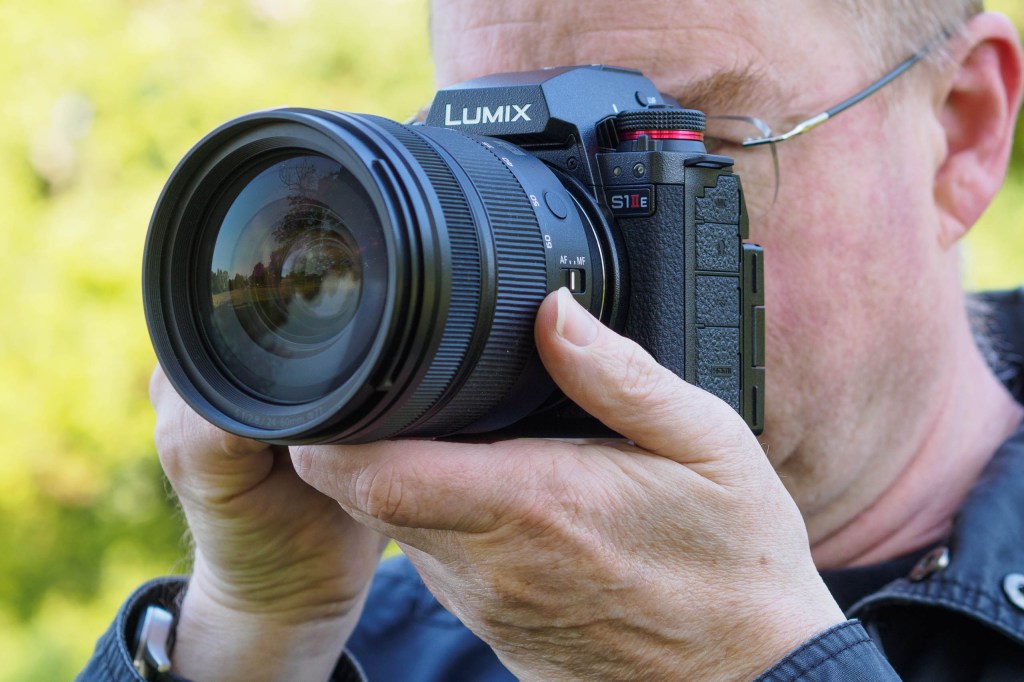
If you’re an existing Panasonic user thinking of upgrading from an original S1 or S5, then this is a massive step forwards. Even if you have an S5II or S5IIX, the more robust and refined body is a real attraction, although there’s no obvious upgrade in terms of image quality. And if you’re sure you don’t need the faster shooting and video frame rates of the S1II, the saving you can make from buying the S1IIE instead will go a long way to paying for a nice lens.
If, however, you’re an enthusiast photographer with no particular allegiance to any brand, then the S1IIE faces some stiff competition. Both the Nikon Z6III and Canon EOS R6 Mark II are about the same price and have better, or at least easier-to-use, autofocus systems, including auto subject detection. But in return, the S1IIE has a more robust-feeling body and an exceptionally versatile screen, so everything depends on which features you’d rather spend your money on.
Overall, though, I can’t help but think that the S1IIE’s main problem lies with its ‘second-best’ positioning within the Lumix line. At this level, I suspect most people would rather buy the S1II, and not feel like they’re missing out on anything. But if you can leap this particular psychological hurdle, you’ll find the S1IIE is a pretty fine camera in its own right.

Follow AP on Facebook, X, Instagram, YouTube and TikTok.
Panasonic Lumix S1IIE full specifications
| Sensor | 24.2MP full-frame BSI-CMOS, 35.6 x 23.8mm |
| Output size | 6000 x 4000 |
| Focal length mag | 1.0x |
| Lens mount | L-mount |
| Shutter speeds | 60-1/8000sec |
| Sensitivity | ISO 100-51,200 (standard), ISO 50-204,800 (extended) |
| Exposure modes | PASM, iAuto, 5x Custom |
| Metering | Multi, centre-weighted, spot, highlight |
| Exposure comp | +/-5EV on 0.3EV steps |
| Continuous shooting | 30fps (electronic), 10fps (mechanical, AFS), 8fps (AFC) |
| Screen | 3in, 1.84m-dot tilt/vari-angle touchscreen |
| Viewfinder | 5.76m-dot, 0.78x OLED, 120fps |
| AF points | 779 |
| Video | 6K 30p, 4K 30p, 4K 60p with APS-C crop, Full HD 120p |
| External mic | 3.5mm stereo |
| Memory card | CFexpress Type B, UHS-II SD; USB-C SSD |
| Power | DMW-BLK22 rechargeable Li-ion |
| Battery life | 380 (LCD), 340 (EVF) |
| Dimensions | 134.3 x 102.3 x 91.8mm |
| Weight | 795g including battery and SD card |









